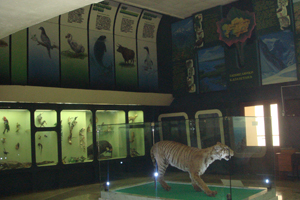Биологический музей Казахского Национального университета им.аль-Фараби
Museum Director - Candidate of Biological Sciences, Musabekov Kylyshbay Salimbekovich
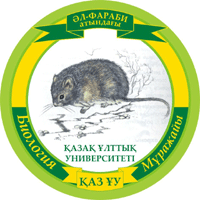 |
Museum of Biology of Al-Farabi Kazakh National University Biological Museum of KazNU was founded in 1936, initially as a zoological museum at the Chair of Zoology of the Faculty of Biology, and then in 1949 it was reorganized into the Faculty’s Biology Museum. Modern life of the biological museum began with the opening of the showroom and external dioramas in 1984 during the celebration of the 50th anniversary of the University. Museum of Biology of the University is unique in its kind not only for the Republic of Kazakhstan, but also for the entire CIS . Biological Museum is a research and scientific and educational center, assisting in leading of the specialists of biological profile: PhD, masters and bachelors.
|
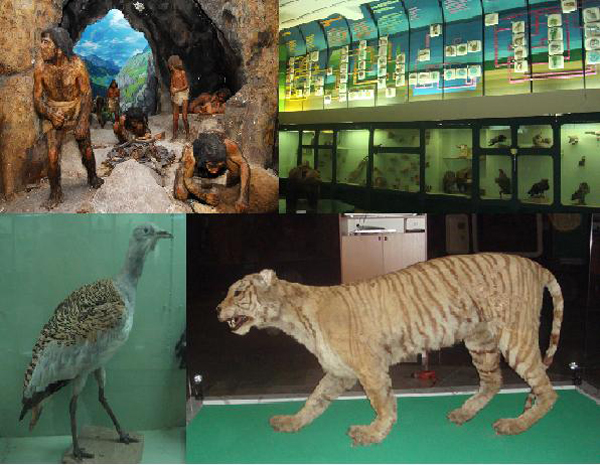
The museum consists of a large hall, in which there are 3 sections and 84 built-in cabinets .The total number of exhibits in the hall and showcases is more than 5000, the museum hasa fund consisting of mammological, ornithological and entomological departments. In the showroom the biological material is systematized by thematic focus, which is based on biological science majors.The result of this approach was the following sections:
I. Biodiversity habitats, ecosystems and natural areas of Kazakhstan;
II. The evolution of the organic world;
III. The Nature Conservancy;
IV. " Systematic of the animal world " on the 1st floor ;
V. " The systematic of the plant world " on the 2nd floor.
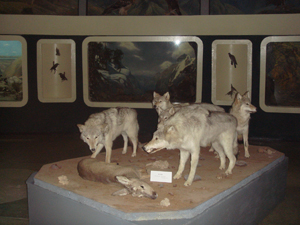 |
I. Biodiversity of habitats, ecosystems and natural areas of Kazakhstan This section covers two compartments in which biodiversity, ecosystems andnatural areas of Kazakhstan presented in spectacular dioramas, standsand maps. In addition, the hall is stuffed with different species of vertebrates (antelope, elk, wolves, bears, squirrels, golden eagle, boradach, wood pigeon, etc.) The seasonal migration of the saiga and basic ways of spring migration of waterfowlKazakhstan are given on the maps. Mammals in the museum consists of 6 squadsand 17 families, the total number of them is 92. The hall exhibited stuffed birds of15 orders 41 families 127 species, the total number of 261. Some species are included in the International (IUCN) and the Kazakhstan Red Book and taken under protection. In addition, dummies of exotic animals, birds and reptiles are exhibited. |
| II. The evolution of the organic world This section provides scientific information aboutthe development of life on Earth and the anthropologyof man. Ambience made microramas (in miniature) conveythe types of plants and animals clearly in the evolutionarydevelopment “From the Silurian to the Cenozoic” (Bureau).The overall picture complements map "Gondwana",whichshows the movement of land since ancient times (180 millionyears ago) to the present state. Panel Diagramof geochronologicaldistribution of major groups of plants and animals, indicating theera, epoch and period providesvaluable educational and scientificinformation. Diorama "Ili ostrich" gives information about the itemsin the CharynCanyon of the numerous fragments of the shells ofeggs of extinct ostrich in the upper, Cenozoic sediments. Thisdiorama was made on the basis of scientific evidence that proves that " Ili ostrich " is the ancestor of modern ostriches. In this section, the exposition devoted to one of the founders of the museum andtaxidermist of high qualificationsEF Rodionov. | 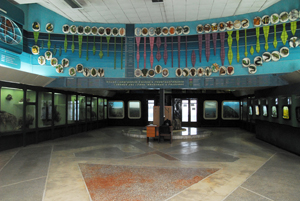 |
|
|
III. "Ecology " and " The Nature Conservancy " In the upper tier there are the stands on both sides with the image of extinct species of animals and rare, endangered species of plants. Top tier is crowned with the map of the USSR with marked largest reserves and 7 stands with the characteristics of Kazakh reserves for 1984. Along with them, in four dioramas a global ecological catastrophe caused by unwise human activities (anthropogenic factors) are shown: the continent of Australia - a deleterious effects of introduced rabbits; changes in the tundra zone because of its rapid development; water pollution and consequences of the oil spill; disaster - debris-flow in the Zailiyskiy Alatau. On the eve of celebrating the 20th anniversary of Independence of Kazakhstan the exhibition “The Turan tiger is the king of tugai forests” was opened. Dummy is restored by taxidermists of Biology Museum.
|
|
IV. 1st floor - Systematics of wildlife. A systematic review of wildlife can be seen in the 40 built-in windows: invertebrates are united in classes 9 and 14 units. Vertebrates - 9 classes, 86 orders, 711 species - the total number of dummies is 765, fixed material, skulls and figures. Among 14 groups of vertebrates, meeting around the world, in Kazakhstan dwell 7 squads, 57 species, the total number of the exhibits is 113. Among the 25 squads of birds in Kazakhstan there are 18 groups of 186 species, 220 exhibits are exposed. |
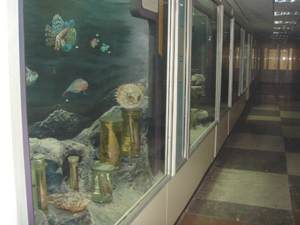 |
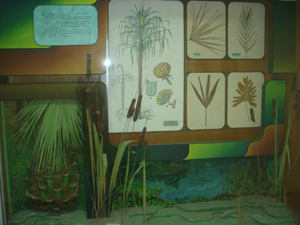 |
V. 2nd floor - Systematics flora A systematic review of the plant world is presented in 26 showcases. Lower plants are: algae, fungi , mosses, lichens and ferns in a herbarium - 42 sheet, the total number is 332 species, higher plants - 151 herbarium sheet, on the podium there are exhibited 51 plants of volumetric drying (mushrooms , twigs , etc.), 40 copies of medicinal plants, 180 copies of fruits and cones, 53 and 24 dummy patterns.
|
Contacts: al-Farabi No. 71, . al-Farabi KazNU, GUK1 |
Mode: 9.00 -17.00 PM(closed for lunch 13.00-14.00) |









